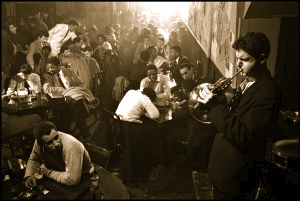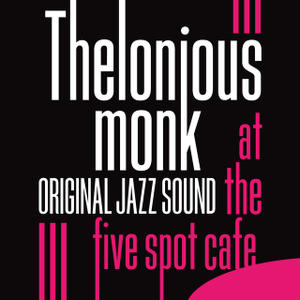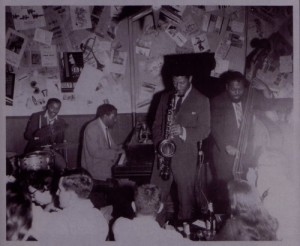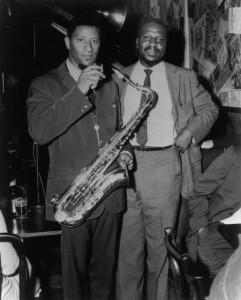The Five Spot

Thelonious Monk and the Five Spot
The 1950’s were about creative consolidation in jazz. A generation of bebop believers was distilling and expanding upon the lessons learned from Charlie Parker and Dizzy Gillespie. And then there were the iconoclasts, all so individual in their music that they defined their own distinct trends: Thelonious Monk, Charles Mingus, Miles Davis and, by the end of the decade, John Coltrane, Cecil Taylor and Ornette Coleman. In the other arts, the ’50s were as alive and expansive—a shared creative thrust was in the air in New York City. Beat literature was gaining ground and favor, as was abstract expressionism—“action painting”—and a new dramatic approach called method acting. If there was a crossroads where all the creative energy overlapped, where artists and writers met actors and musicians, and all listened to the newest of the new, it was a small storefront bar in the East Village. Joe and Iggy Termini owned the joint and were inspired to buy a piano and begin booking bands after hearing the jam sessions at a customer’s loft. Less jazz-aware than simply hip to the need for a cultural center, the Termini brothers benefited from great timing. Their decision coincided with the return of Thelonious Monk’s cabaret card, originally lost in an effort to prevent a drug bust on Bud Powell. The reinstatement allowed the pianist to return to live performance in Manhattan, and through the club’s inaugural summer, Monk’s legendary quartet held forth with John Coltrane struggling to handle the changes. Of course, Coltrane learned fast—and so did New York’s hipster scene. With no cover charge or minimum at the outset, the Five Spot was soon regularly packed (not difficult with a capacity of 75) and history was being made on a nightly basis. Over the next few years, the bar played host to an incredible array of talent, whether performing or just dropping by. It was possible to hear Allen Ginsberg or Kenneth Koch read poetry on one night and Lester Young play his saxophone the next while Mark Rothko and Norman Mailer sat in attendance. In November 1959, the Five Spot earned enduring fame in the jazz annals when Ornette Coleman arrived from Los Angeles and turned the entire jazz world on its ear with an historic two-week run. Bassist Charlie Haden recalls peering from the bandstand to see every bassist of renown lined up at the bar to witness the event. City renewal plans forced the original club to close in 1962; Mingus led the final performance. Though it soon reopened just a few blocks north (St. Marks and Third Avenue) and remained in business into the early ’70s, the Five Spot never regained its edgy stature. In Dan Wakefield’s anecdotal survey of the decade—New York in the ’50’s—he describes a hierarchy of hip measured by the club one attended, and how the jazz-savvy worked their way up that ladder. The chapter title: “Graduating to the Five Spot.”
 The Five Spot Café was a jazz club located at 5 Cooper Square in the Bowery neighbourhood of New York City.
The Five Spot Café was a jazz club located at 5 Cooper Square in the Bowery neighbourhood of New York City.
History
In 1937, Salvatore Termini (b. 1884) purchased what was then known as the Bowery Café, a working-class bar located under the Third Avenue El. In 1946, two of Termini’s sons, Joe and Ignatze (Iggy), returned from the war and helped run the bar. In 1951, the sons purchased the business from their father and renamed it the No. 5 Bar.
In late 1955 the Third Avenue El was demolished and the city embarked on a revitalization of the Bowery. During this time many artists were drawn to the area due to the cheaper rent prices compared to Greenwich Village. Pianist Don Shoemaker was among the influx of artists who moved re-located to the Bowery. Occupying a studio at 1 Cooper Square above the No. 5 Bar, Shoemaker hosted jam sessions during which he would purchase beer from the Terminis. Shoemaker eventually told Joe that if the bar would purchase a piano, he and his band would play. Joe bought a used upright piano, received a cabaret licence on 30 August 1956, and opened a week later under the name the Five Spot Café. Artists such as painters Herman Cherry, David Smith, Willem de Kooning, Franz Kline, Joan Mitchell, Alfred Leslie, Larry Rivers, Grace Hartigan, Jack Tworkov, Michael Goldberg, Roy Newell, Howard Kanovitz and writers Jack Kerouac, Allen Ginsberg, Frank O’Hara, Ted Joans, and Gregory Corso began frequenting the club.
 The first official engagement at the 5 Spot was Cecil Taylor, whose band featured Buell Neidlinger on bass and Dennis Charles on drums. Later, Steve Lacy (then still Steve Lackritz) was added to the band. Originally, Taylor’s band was initially hired to accompany Dick Whitmore, but Whitmore quit after three nights, giving the job to Taylor. The gig lasted from 29 November 1956 to 3 January 1957.
The first official engagement at the 5 Spot was Cecil Taylor, whose band featured Buell Neidlinger on bass and Dennis Charles on drums. Later, Steve Lacy (then still Steve Lackritz) was added to the band. Originally, Taylor’s band was initially hired to accompany Dick Whitmore, but Whitmore quit after three nights, giving the job to Taylor. The gig lasted from 29 November 1956 to 3 January 1957.
On 4 July 1957, Thelonious Monk‘s quartet featuring John Coltrane on tenor saxophone, Wilbur Ware on bass, and Shadow Wilson on drums began a six month stay at the club. Ware was later replaced by Ahmed Abdul-Malik, Coltrane by Johnny Griffin, and Wilson by Roy Haynes. This was Monk’s first extended engagement.
Ornette Coleman Quartet New York debut
 On 17 November 1959, the Ornette Coleman Quartet from Los Angeles made its New York debut at the Five Spot. The Quartet featured Coleman on alto saxophone, Don Cherry on cornet, Charlie Haden on bass, and Billy Higgins on drums. The engagement was originally scheduled to last two weeks, but due to its success was extended to ten weeks, ending in late January 1960. Musicians such as Leonard Bernstein, Miles Davis, and John Coltrane were among the attendees on the opening night. On 5 April 1960 the quartet returned to the Five Spot for a second engagement which lasted four months, thus ending in late October 1960. This second engagement featured Ed Blackwell on drums replacing Higgins.
On 17 November 1959, the Ornette Coleman Quartet from Los Angeles made its New York debut at the Five Spot. The Quartet featured Coleman on alto saxophone, Don Cherry on cornet, Charlie Haden on bass, and Billy Higgins on drums. The engagement was originally scheduled to last two weeks, but due to its success was extended to ten weeks, ending in late January 1960. Musicians such as Leonard Bernstein, Miles Davis, and John Coltrane were among the attendees on the opening night. On 5 April 1960 the quartet returned to the Five Spot for a second engagement which lasted four months, thus ending in late October 1960. This second engagement featured Ed Blackwell on drums replacing Higgins.
- Pepper Adams – 10 to 4 at the 5 Spot (Riverside, 1958)
- Kenny Burrell – On View at the Five Spot Cafe (Blue Note, 1959)
- Eric Dolphy – At the Five Spot (Prestige, 1961)
- Charles McPherson – The Quintet/Live! (Prestige, 1966)
- Thelonious Monk – Thelonious in Action (Riverside, 1958)
- Thelonious Monk – Misterioso (Riverside, 1958)
- Randy Weston – Live at the Five Spot (United Artists, 1959)


